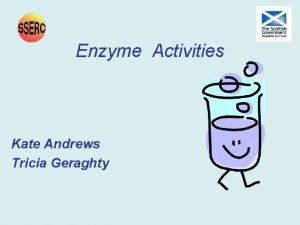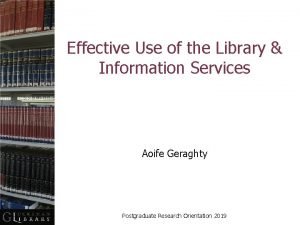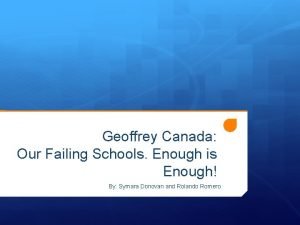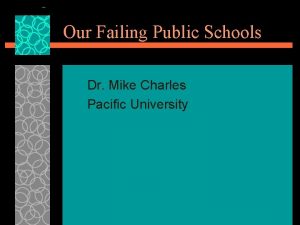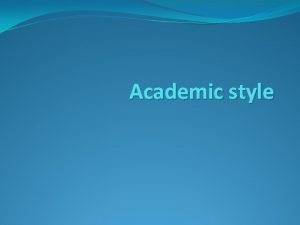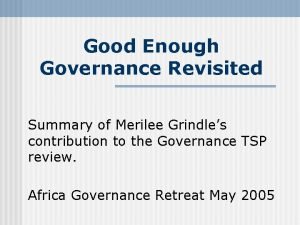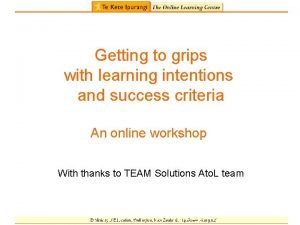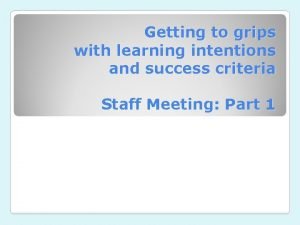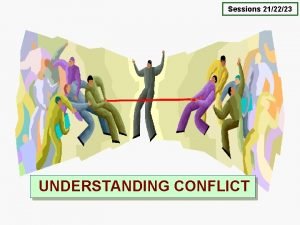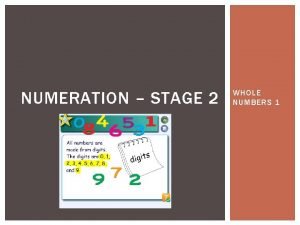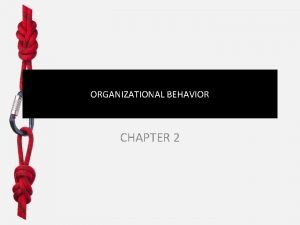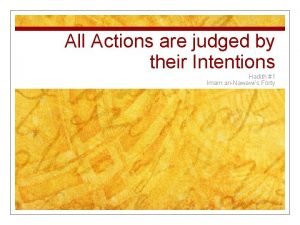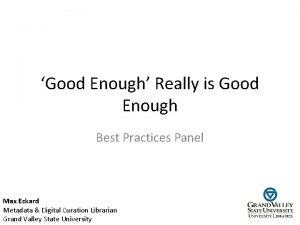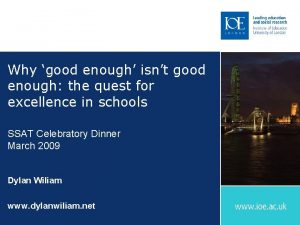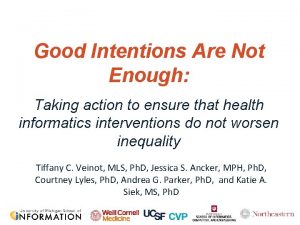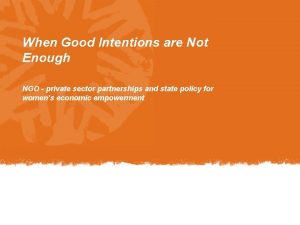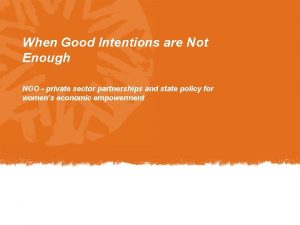Good Intentions Good Enough Mark Geraghty CEO Principal




































- Slides: 36

Good Intentions, Good Enough? Mark Geraghty CEO & Principal Seashell Trust Nat. SIP Working Day – Friends House, London 6 th February 2018

Random Funny

Secretary of State Justine Greening 6 th November 2017 Since we passed the Children and Families Act , 2014 , the special educational needs and disability (SEND) sector has made huge strides on the identification and assessment of children and young people with SEND , and planning to meet their needs. As your report rightly identifies, it is now time to increase our focus on the quality of the support that these children and young people receive.

Secretary of State Justine Greening 6 th November 2017 Your report makes clear that there is some excellent practice by schools, colleges, local authorities and other services, and this should be celebrated. But it also makes clear that , too often, this excellent practice is in spite of, rather than because of, how the system works currently.

Why Now? • A 25+ year gap since the last review • A number of identified challenges - a need for new models ? • Need to recognise excellence • A changing population …levels of complexity • Follow up to Sir Martin Narey’s review

We Had Questions? • Who are the children and young people (C&YP) currently in residential special schools and colleges? • How many C&YP are in RSS&C • How, and why, do these C&YP come to be placed in residential special schools and colleges?

We Had Questions? • What is the pattern of provision across the country and how it is commissioned and procured? • What does good quality support looks like for C&YP, both pre- and post-placement (including a review of the role of early intervention, family support and community services)?

We Had Questions? • What are the experiences and outcomes of these C&YP and their families? • How can these can be improved? • How are the workforces (RSS&C) meeting the needs of C&YP, acknowledging the changing complexity? • What are the destinations for these C&YP

Random Funny

Context – The Most Complex • Currently 1122 children and young people with learning disabilities and / or autism placed in residential schools for 52 week placements. • Ranges from 0 - 36 children and young people per local authority area. • Those with the highest numbers are not those who proportionally place the most children and young people

Context – the Most Complex • Projected estimation of 100% return would indicate that a likely England wide picture is that 1, 137 children and young people with learning disabilities and /or autism are placed in 52 week residential schools. • At June 2017, this is 205 in-patients with learning disabilities and/or ASD aged under 18 years • Further 635 aged 18 -25 years.

Understanding Who and What? • Just under 5, 000 children residential placements • Another 1, 200 post 16 young people board • Costs range from £ 35, 000 to £ 350, 000 with totals at over £ 500 m pa • Over 80% of children, in RS&SC have either ASD or SEMH, or both • Two smaller groups, children with PMLD/sensory/ communication impairments

What We Found • Found variable practice; excellence to inadequate • Poor relationships between all stakeholders; LAs, CCGs, Social Care and RSS&C resulting in lack of effective collaboration • Educational outcomes not as good as they could be!

What We Found • Children internalising failures of the system i. e. seeing it as their own failure • Lack of mental health support and training for the workforce

Children as Part of their Community • Need to create incentives for mainstream • Recognise the role of short breaks, to support families • Wraparound mental health support for families • Essential to tackle bullying in schools

Random Funny

Children as Part of their Community • Robust data and capacity planning – essential • Supporting innovation – examples of working differently • Local /sub regional/national…. what is the footprint?

Placements and Planning • Establish how families should be supported • Finding the right placement e. g. do LAs commission or shop for places? • Essential to building positive relationships across all stakeholders

Placements and Planning • Delivering on legal responsibilities and building effective links based on these foundations • Understanding the sector as a whole i. e. who is controlling the market place?

Quality in Placements • Safeguarding and links with host or home LAs • Leadership in schools and colleges - support • School improvement (mainstream) – raising awareness of SEND

Quality in Placements • Children's experience - generally good in RSS&C • Use EHCPs as a commissioning document? • Why are C&YP placed away from home? • Understand what drives the SEND Tribunal outcomes

Outcomes and Destinations • Supporting improved educational outcomes for C&YP – who's best placed? • Improve our understanding of progress and tracking, for all SEND children • Tackling poor aspirations • Understanding destinations – Pf. A is central to the decision making processes

Random Funny

What Does this Mean for SEND - Support Services? • The best place for C&YP is with parents/ carers - huge role for SEND-SS • To achieve this we need good schools and colleges - SEND-SS is the key to unlock this enigma • Setting high aspirations for their pupils and students - best achieved alongside high performing peers, but comes with risk!

What Does this Mean for SEND-SS? • Develop good relationships with LAs - SEND-SS to support transitional arrangements for C&YP • Improve links with their local safeguarding arrangements – who leads in specialist SEND-SS around safeguarding? • SEND-SS to support external benchmarking – what does good look like for LISEN C&YP?

What Does this Mean for SEND-SS? • The focus and financial pressure is on High Needs Low Incidence (yet to be fully defined) • Regionalisation is an emerging strategy, alongside other educational drivers e. g. social mobility and the indefatigable march toward Academies and Free Schools • Status quo is not an option – be in control of the change, don’t let the change control you.

Included the Report's recommendations, for your reference only!

The Report’s Recommendations • Recommendations for Df. E • The Df. E should support LAs, working with CCGs as necessary, to make the best use of data and forecast need effectively, and give them an avenue through which to create new provision where a requirement is identified. Providers should also be involved in these discussions. • The Df. E and should work with LAs to improve understanding of when is and isn’t appropriate to contest a parents’ or young person’s choice of placement, and the SEND Tribunal should produce a regular digest of significant cases to reinforce this learning. • The Df. E publishes LA visiting guidance, setting out expectations for when LAs should visit children and young people in residential special schools and colleges.

The Report’s Recommendations • Recommendations for Df. E • The Df. E should consider how the mainstream school and college workforce can improve their understanding of the reasons for challenging behaviour, and the proactive steps they can take to reduce it for children with autism and SEMH. • The Df. E should develop a strategy to ensure mainstream schools and colleges ca n meet the needs of children and young people with SEND. This should include providing greater incentives to schools and colleges to do their best for this cohort , and ensuring that leaders in mainstream have the skills and vision to meet these children an d young people’s needs. • The Df. E should ensure that LAs are offering sufficient short breaks to the families of children and young people with SEND.

Personal Conclusions • There is unquestionably a role for RSS&C - at their best, they provide a unique level of expertise and support. • How do we support quality improvement for these C&YP across maintained Schools, GFE Colleges, NMISS and ISC sectors? • GIGE is the first step in a change process; role of all stakeholders on the next steps, will be mission critical

The Report’s Recommendations • Recommendations for Df. E • The Df. E should clarify how the Public Contracts Regulations apply to • • independent/non-maintained special schools. The Df. E should replace the national minimum standards for residential special schools with national quality standards. The Df. E should clarify who is responsible for the safeguarding of children placed within area by another LA. The Df. E should consider what more can be done to promote and support school improvement in special schools. This should include promoting and facilitating greater links between mainstream and special schools. The Df. E should improve the supply of quality school leaders to the special schools and colleges sector.

The Report’s Recommendations • Recommendations for Df. E • The Df. E should require independent schools with state - funded pupils to complete the school census for those pupils. • The Df. E should publish destinations data for children and young people that have attended residential special schools and colleges, taken from the longitudinal educational outcomes data set. • The quality standards recommended above should require that schools demonstrate how they are achieving ambitious outcomes for children and young people, particularly those set out in EHC plans. • The quality standards recommended above should include significant focus on how schools and colleges are ensuring progress against the four Pf. A domains.

The Report’s Recommendations • Recommendations for Df. E • The Df. E should create a national leadership board for children and young people with high needs, reporting to the Minister for Children and Families, to take forward the recommendations of this review, provide strategic oversight to the services they need, and sup port collaborative working between LAs, CCGs and providers. Links should be made with other boards for vulnerable children as appropriate.

The Report’s Recommendations • Recommendations for Df. E and DH • The Df. E and DH should, in response to the upcoming green paper on children and young people’s mental health, set out how mental health support will be delivered for children and young people with SEND. • The Df. E and DH should explore, with a view to piloting, how accountable care systems can lead to more coherence across education, health and care for children and young people with SEND. • To provide an evidence base on which discussions about fees can be based, the Df. E and DH should, through research, establish the average costs of services provided to children and young people with high needs.

The Report’s Recommendations • Recommendations for local authorities • Local authorities, working regionally with CCGs, parents and young people, should plan and commission provision strategically to meet upcoming patterns of demand, locally where possible. • To support this, local authorities should build understanding and data about local and regional trends in SEND needs.

The Report’s Recommendations • Recommendations for local authorities NASS and Natspec • NASS and Natspec should encourage their members to be flexible on the fees they charge, and work with them to develop open - book accounting. • NASS and Natspec should ensure their members know where to access school improvement expertise.
 Im good enough i'm smart enough and doggone it
Im good enough i'm smart enough and doggone it Tricia geraghty
Tricia geraghty Aoife geraghty
Aoife geraghty Our failing schools enough is enough
Our failing schools enough is enough How much vs how many
How much vs how many Our failing schools enough is enough summary
Our failing schools enough is enough summary Good intentions
Good intentions Good enough test
Good enough test Close enough randy
Close enough randy This test isn't good enough in academic writing
This test isn't good enough in academic writing Good enough governance
Good enough governance Good enough governance
Good enough governance Poetry learning intentions
Poetry learning intentions Examples of learning intentions
Examples of learning intentions Learning intentions and success criteria examples
Learning intentions and success criteria examples Creative intention meaning drama
Creative intention meaning drama Learning intentions and success criteria examples
Learning intentions and success criteria examples Conflict of interest definition
Conflict of interest definition Persuasive writing learning intentions
Persuasive writing learning intentions Write a number in expanded form. 637
Write a number in expanded form. 637 Poem annotation generator
Poem annotation generator Fractions objectives
Fractions objectives Half-turn symmetry
Half-turn symmetry Verb viper
Verb viper Poetry learning intentions
Poetry learning intentions Learning intentions and success criteria for mathematics
Learning intentions and success criteria for mathematics Poetry learning intentions
Poetry learning intentions Peacock poem
Peacock poem Reflective phrases
Reflective phrases Poem success criteria
Poem success criteria Arrangement prediction intention
Arrangement prediction intention Floral design
Floral design Personal attitudes affect behavior via intentions
Personal attitudes affect behavior via intentions Drama learning intentions
Drama learning intentions Undeclared intentions
Undeclared intentions Actions are judged by intentions
Actions are judged by intentions Heb 4:12 amp
Heb 4:12 amp

